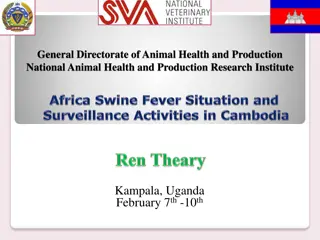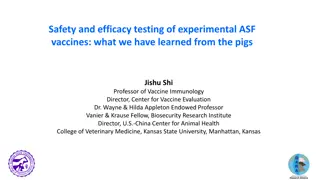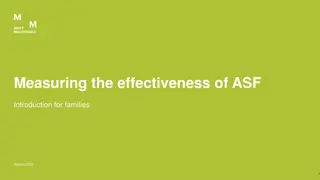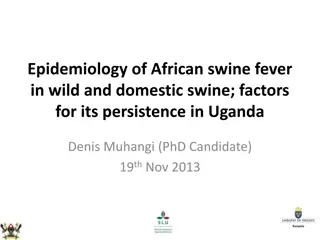
ASF Epidemiology and Control Efforts in Uganda
Explore the African Swine Fever (ASF) situation in Uganda, focusing on pig farming and key transmission mechanisms. Learn about ASF outbreaks, risk factors, and interventions to minimize spread. Presented by Paul Lumu on behalf of CVO, Dr. Anna Rose Ademun from the Ministry of Agriculture, Animal Industry, and Fisheries in Uganda.
Download Presentation

Please find below an Image/Link to download the presentation.
The content on the website is provided AS IS for your information and personal use only. It may not be sold, licensed, or shared on other websites without obtaining consent from the author. If you encounter any issues during the download, it is possible that the publisher has removed the file from their server.
You are allowed to download the files provided on this website for personal or commercial use, subject to the condition that they are used lawfully. All files are the property of their respective owners.
The content on the website is provided AS IS for your information and personal use only. It may not be sold, licensed, or shared on other websites without obtaining consent from the author.
E N D
Presentation Transcript
Title: ASF Country situation and control efforts Presenter: Paul Lumu on behalf of CVO, Dr. Anna Rose Ademun Country and institution: Uganda, Ministry of Agriculture Animal industry and Fisheries
Background and introduction The livestock subsector is one of Uganda s crucial sectors with prospects of improving livelihoods of the rural poor. Pig farming is one of the key enterprises for the Small holder farmers who are the majority in the Agricultural sector in Uganda. In Uganda, the pig sector is largely dominated by smallholders, who collectively constitute more than 90% of the agricultural system. Pig farming is one of the fastest growing livestock enterprises in Uganda, with 17.8% of households rearing pigs (UBOS, 2011). By 2016, there were 4.0 million pigs and it s the fastest growing livestock enterprises
ASF epidemiology Reservoir in soft ticks Survival > three years recorded Asymptomatic infection in warthogs and bushpigs Two main mechanisms of transmission Sylvatic: Ticks feed on warthogs to domestic pigs? Current quantitative importance unclear The role of the bushpig? Refer to a study around Murchison NP Domestic pig to pig cycle particularly in urban & peri-urban areas??? perhaps the most important mode of transmission? Where is the reservoir? (soft tick?)
Risk Factors Associated with spread of ASF & Interventions to minimize Poor husbandry practices and poor on farm biosecurity measures (purchase of replacement stock without testing or initial isolation, sharing of breeding boars, free- range husbandry system and allowing access of visitors onto farms without disinfection) Increased prevalence of the Vector Feeding of Swill without taking the necessary precautions Increased Wildlife-livestock interface due to the decreasing land availability hence encroachment to the protected areas Increased movements of pigs during suspected ASF outbreaks to mitigate losses by the farmers due to the disease. .
Interventions to minimize ASF Spread. 1. Instituting Movement restrictions where ASF outbreaks have been confirmed by PCR. Training of farmers on biosecurity measures especially in the hot spot areas by the Ministry, District Veterinarians, Community based organizations, NGOs, Pig farmer platforms, Press releases, Electronic Media. 2. Destruction of the infected flock has been recommended but difficult to implement since there is no direct way of compensating the farmers. Development of the ASF control strategy with support from FAO is underway. Sourcing stock from disease free districts and farms (Screening).
On-going research Next generation sequencing of the ASF viruses from outbreaks Various efforts on vaccine development by consortium partners at Makerere, NARO, Gulu University






















